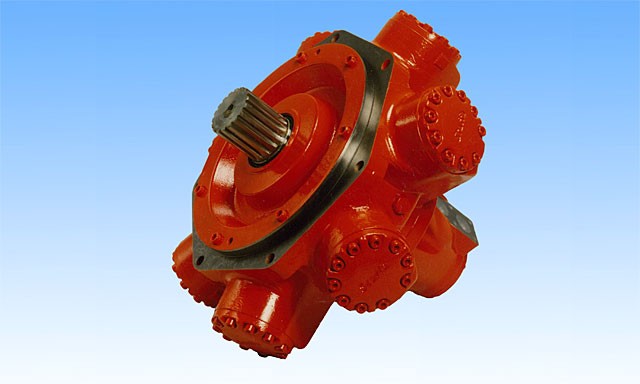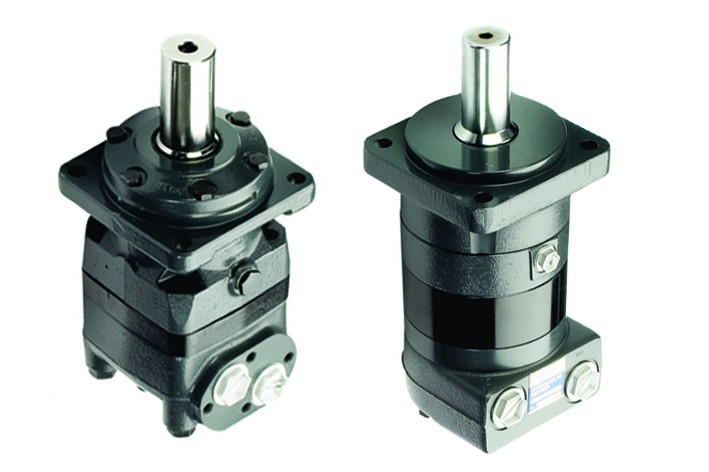

Hydraulic motors convert fluid pressure into rotary motion. They are rotary actuators that enable fluid energy to turn into mechanical power. Working together with a hydraulic pump pressurised fluid turns the motor output shaft by pushing on the gears, pistons or vanes of the hydraulic motor. The speed of the hydraulic motor is determined by the amount of fluid supplied by the hydraulic pump, while torque is dependent on pressure.

Torque is the turning and twisting effort of the motor and is described in three levels: Breakaway, running and starting.
The minimum torque needed to start a motor when under no load.
Running torque is the torque required to keep the motor running and load running.
This is the minimum torque required to overcome the force of the load and internal motor friction. Or the torque needed to start the motor under load.
There are currently five main hydraulic motor designs in use today: orbital, gerotor, gear, vane and piston. Each of these designs has their own variations.
Within these designs hydraulic motors can be fixed-displacement or variable-displacement operating bi-directionally or uni-directionally. Variable-displacement hydraulic motors vary the flow rates and, thus, provide variable torque and speed.
One of the most common motors is an orbital or gerotor type, these have an inner drive gear and an outer gear ring. The outer has one more tooth than the inner. The inner gear is supported by the shaft which is connected to the load and is rotated by the hydraulic fluid. Orbital motors are considered low speed, high torque.
Gear motors typically include two gears - the driving gear (connected to the drive shaft) and the idler gear. High pressure oil is delivered into a side of the motor, where it flows around the outside of the gears causing them to rotate. Gear motors have a relatively low operating pressures and therefore relatively low torques, but they can rotate at a reasonable speed. Applications include fan drives and cutter blades. Gear motors are generally lightweight and low-cost units.
A vane motor has a rotor located within an eccentric bore. Vanes are held within the rotor and slide out, due to centrifugal force, and in, to follow the profile of the bore. The rotor spins due to the pressure differential acting on the vanes. Vane motors internal leakage is relatively high compared to other motor designs but they have the advantage of low noise operation.
Piston motors come in two forms, Radial and Axial. Axial motors offer higher speeds than radial but are do not have the high displacement capacities of radial motors. Piston motors are ideal for applications that require a significant amount of power.
Radial piston hydraulic motors have a cylinder barrel attached to a driven shaft. They can usually produce more torque than axial piston hydraulic motors but don’t run at such high rpm.
They can be either fixed displacement or variable. Radial piston motors deliver a high level of torque and are extremely efficient.
Using axially mounted pistons to generate mechanical energy, an axial piston motor can develop high torques and high speeds. Axial piston hydraulic motors have good volumetric efficiency, allowing steady speed under variable torque. Piston motors are adept at dealing with varying load conditions.
There are two designs of axial piston motors - swashplate and bent axis. Swashplate axial motors have the pistons and drive shaft in a parallel arrangement. Whereas bent axis axial piston motors feature the pistons arranged at an angle to the main drive shaft.

Hydraulic motors provide a high power to density ratio and can be applied to most application where an electric motor can be used. However, hydraulic motors require no electricity and can withstand environmental extremes such as heat and submersion. Hydraulic motors are well adapted for the use in mobile machinery due to their useful mounting versatility and reliability.
Hydraulic motors are used in industrial applications, they’re the drive for most off-highway equipment and they’re used in wheel motors, tracked vehicles and drill rigs, to name just a few applications.
When designing a hydraulic system, the motor selection will typically come first due to the application’s load requirements. Motors are selected according to the to the application and operating conditions and each has its own advantages over others for different performance requirements. Cost evaluation will also need to come into the equation which is also dependent on your complete hydraulic solution.
Each motor type has its own advantages where they are a better choice than other motors. The final decision will always depend on what is required in terms of application performance and motor life versus cost.
Posted by admin in category Hydraulic Motors Advice on Friday, 21st January 2022
Call our knowledgeable team Mon–Fri 8:30am–5pm
Systems & Components Division 01427 874445
sales@hydrastore.co.uk
Hose Division 0121 326 6395
hoses@hydrastore.co.uk
Hydrastore use cookies to make the site run smoothly, enhance the content and to gather information on how you use it in order to improve and personalise your experience. See our Privacy Policy

